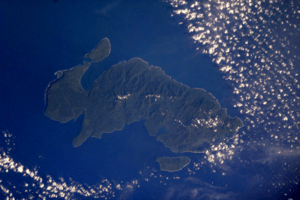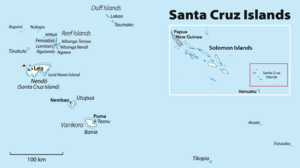Nendö Island facts for kids

Nendö is the biggest island in the Santa Cruz Islands. It's part of the Temotu province in the Solomon Islands. People also know this island as Santa Cruz, Nendo, Ndeni, Nitendi, or Ndende. The name Santa Cruz was given to the island in 1595 by the Spanish explorer Álvaro de Mendaña de Neira. He tried to start a new settlement there. Long ago, it was also called New Guernsey or Lord Egmont's Island.
Contents
Geography of Nendö
Nendö is about 40 kilometers (25 miles) long and 22 kilometers (14 miles) wide. Its total land area is about 505.5 square kilometers (195 square miles). The highest point on the island reaches 549 meters (1,801 feet) above sea level.
Two smaller islands, Malo and Nibanga, are very close to Nendö. They are only about 1 kilometer (0.6 miles) away. Malo is to the northwest, and Nibanga is to the southeast.
Lata is the main town on Nendö. It is located in the northwestern part of the island. Lata is also the capital city of the Temotu province.
Luova Airport, found at Graciosa Bay, helps people travel to and from Nendö.
Nature and Wildlife
Nendö and the nearby island of Malo are special places for birds. BirdLife International has named them an Important Bird Area (IBA). This is because they are home to the Santa Cruz shrikebill, a bird found only on these islands. This bird is sometimes called the Nendo shrikebill.
However, the birds and their homes face some dangers. These include logging (cutting down trees) and strong storms called cyclones.
Earthquakes on Nendö
Nendö is located in an area known as the Ring of Fire. This means that earthquakes happen often here. Some of these earthquakes can be quite strong.
History and People
In 1595, the Spanish explorer Álvaro de Mendaña de Neira found Nendö Island. He was trying to find the Solomon Islands again. He named the island Santa Cruz. Mendaña landed at a place he called Graciosa Bay, which still has that name today.
The Spanish tried to start a settlement there. At first, things went well with the local islanders and their chief, Malope. They helped the Spanish build things and provided food. But many Spanish settlers became sick, likely with malaria. Some soldiers caused trouble, leading to fighting with the islanders. Sadly, Chief Malope was also killed.
The settlement faced many problems and people kept getting sick. Mendaña himself died in October 1595. His wife, Isabel Barreto, took over as leader. In November 1595, they decided to leave the settlement. Many people had died, and this first European colony in the South Seas ended.
In 1767, Philip Carteret arrived at the island on his ship, HMS Swallow. He called it "Lord Egmont's island" but knew it was the Santa Cruz that the Spanish had found. After some friendly meetings, misunderstandings led to conflicts. Both the British and the islanders were hurt. Carteret saw many villages along the coast. He noted that the island seemed to have many people. They also had pigs, chickens, coconuts, and other foods. However, due to the conflicts, Carteret could not trade for the food his crew needed.
Population and Languages
Nendö has a population of just over 5,000 people. Most of the people who live there speak a language called Natügu. There are also about 200 people who speak Nanggu, which is a similar language. Both Natügu and Nanggu are part of the Reefs – Santa Cruz languages family.
Other languages from the Temotu province are also spoken on Nendö. These include Äiwoo and Vaeakau-Taumako, which is a Polynesian outlier language.
Culture and Traditions
From 1966 to 1967, a German expert named Gerd Koch studied the culture of Nendö. He also studied other Santa Cruz Islands. In 1971, Koch published a book about the culture of these islands.
Koch brought a special boat called a Tepukei back to the Ethnological Museum of Berlin. This Tepukei was an ocean-going outrigger canoe. It was the last complete one from the Santa Cruz Islands at that time.
See also
 In Spanish: Nendö para niños
In Spanish: Nendö para niños



